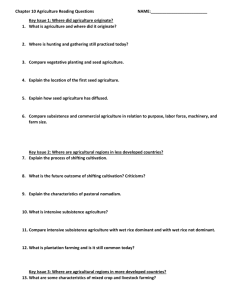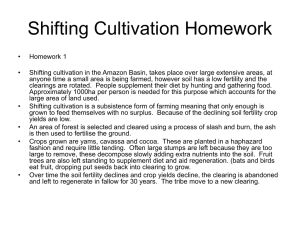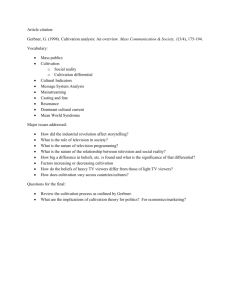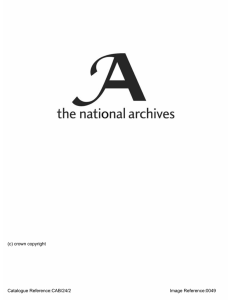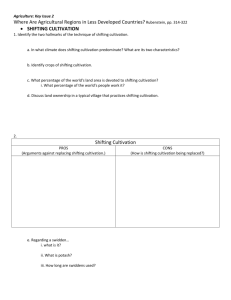ISSN: 2278-6236 ROLE OF BREKLUM MISSION IN ECONOMIC DEVELOPMENT OF KORAPUT
advertisement
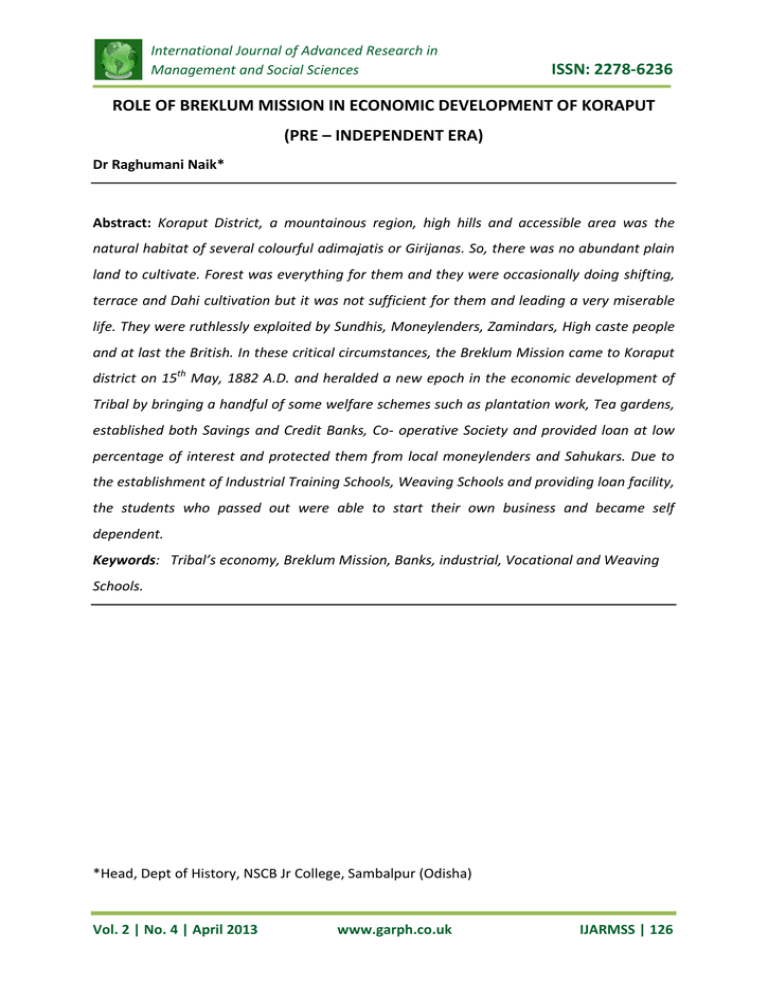
International Journal of Advanced Research in Management and Social Sciences ISSN: 2278-6236 ROLE OF BREKLUM MISSION IN ECONOMIC DEVELOPMENT OF KORAPUT (PRE – INDEPENDENT ERA) Dr Raghumani Naik* Abstract: Koraput District, a mountainous region, high hills and accessible area was the natural habitat of several colourful adimajatis or Girijanas. So, there was no abundant plain land to cultivate. Forest was everything for them and they were occasionally doing shifting, terrace and Dahi cultivation but it was not sufficient for them and leading a very miserable life. They were ruthlessly exploited by Sundhis, Moneylenders, Zamindars, High caste people and at last the British. In these critical circumstances, the Breklum Mission came to Koraput district on 15th May, 1882 A.D. and heralded a new epoch in the economic development of Tribal by bringing a handful of some welfare schemes such as plantation work, Tea gardens, established both Savings and Credit Banks, Co- operative Society and provided loan at low percentage of interest and protected them from local moneylenders and Sahukars. Due to the establishment of Industrial Training Schools, Weaving Schools and providing loan facility, the students who passed out were able to start their own business and became self dependent. Keywords: Tribal’s economy, Breklum Mission, Banks, industrial, Vocational and Weaving Schools. *Head, Dept of History, NSCB Jr College, Sambalpur (Odisha) Vol. 2 | No. 4 | April 2013 www.garph.co.uk IJARMSS | 126 International Journal of Advanced Research in Management and Social Sciences 1. ISSN: 2278-6236 INTRODUCTION: Koraput District was the natural abode of several tribal communities known as Adivasi. These Tribal habitats nestle around topographical features with scenic beauty. Due to hilly regions, there were no ample of plain lands to cultivate. Therefore, the people were solely depending upon forest and occasionally doing ‘Podu’ or shifting,Terrace and Dahi cultivation but it was not sufficient for them. The economic life of the tribals had remained at the subsistence level and it revolved around agriculture, forest, animal husbandry and wagery. Monsoon was the only source of water for cultivation. Unproductive nature of the soil, irregularities in rain fall and the low level of technology gave a very little output. In other words, they lived in a state of subsistence economy with very little source of supplementary income. The persistent poverty and lack of basic means of livelihood undermined the socio-economic and health conditions of tribal people. 2. TRAIT OF TRIBAL ECONOMY: a. The tribal economy mostly clustered round the forest. b. The tribals had very inadequate access to natural resource endowment and were primitive in technology. c. As of their impoverishment and unawareness, they were often more exploited by various agencies such as Sundhis, Sahukars and Zamindars etc. d. The quality of available land in the area habited by the tribal was generally very poor and less productive. e. Agriculture, agricultural wagery labour and non-agricultural wagery worker, collection of minor forest products and food gathering were the activities which were mostly carried on simultaneous by the tribal for their living. The following major agricultural patterns built into the structure of tribal economy were A. Shifting or Podu or Jhumming cultivation Shifting cultivation was also known as Jhum or Jhumming cultivation. Due to diminution of fertility, they used to shift to another area and thus it was known as shifting cultivation. Shifting cultivation was practised by the people on hill areas on a large scale. It was cultivated by rotation on the hill tops and slopes by slash and burning the fallen trees and bushes and dibbling of broadcasting seeds in the ash covered soil. Harvest was very good for the first two or three years but it gradually fell in the following years and then the land was Vol. 2 | No. 4 | April 2013 www.garph.co.uk IJARMSS | 127 International Journal of Advanced Research in Management and Social Sciences ISSN: 2278-6236 left fallow for a period of four years and spared until it regained some of its fertility through renewed vegetation. During this time, they took up another cleaning for shifting cultivation. The operation of shifting cultivation was also known as “Podu” cultivation. The tribals compelled to live in wild conditions because of the lack of resourcefulness, inferiority complex, primitive conservatism and deep rooted tradition. In Koraput District, Shifting cultivation was practised by Bonda, Dangaria Kandh, Didiayi, Koya, Gadaba, Kuttia, Kand and Paraja tribes. The major crops grown by this process were minor millet, finger millet, paddy, Ragi, Jowar, Niger, and Ginger etc. Apart from that, they were cultivating Kuhuri (Panicum Millaceum), Maize, Winter Paddy, Cereals, Pulses,, Millets, Panikuhuri (Pancum Millare), Swan ( Panicum frumentaceum, Jhari (Panicum Colonum), Jandal ( Sorghumvulgare), Kanga and Aga ( Setaria italic), Kalika (Phaseolus Aconti Folius), Ragi (Eleucine Coracene), Bajra ( Peniseturn Typhid eum) and Suan (Echnochois Frumentaceas). Other important crops were Dahi paddy (Upland paddy),Kandula ( Cajanus cajan) ,Kalaka (Penicum italicum), Kangu (penicum milcare), Janha (Sunghum vulgure),Kairi ( Millet),Kolatha ( Dolichos biflorus, horse gram), Biri ( Green gram),Maka ( Maize), Rasi ( Sesamum indicum), Sorisa ( Mustard),Haldi (Duruma lenga), Kaunria ( Hibacus cannabinus),Jhudanga (Pulses), Gunji ( Millet), Mandia (Eleusine Corocana), B. Terrace or Wet land cultivation This cultivation was generally carried out on flat, gentry and sloping land in areas, where water was likely to be available or it could be nearly retained by terracing. It was wetland cultivation and here the production was higher than the shifting cultivation. Flatness was the cumulative result of centuries of erosion by rain water in the hills, leaving a thin layer of soil. In the rainy seasons, the fields were found wet but perhaps due to rocky nature of the terrain which generated much heat they were unfit even for wild vegetation. In winter, the soil became too dry to support even the growth of grass. Hence, there was natural barrier to the availability of suitable fields of slopping land for terrace cultivation. C. Dahi cultivation It was another form of shifting cultivation practiced by the hill tribals. This was otherwise known as Nala. The flat hill - top or the plain land located at the foot of the hill below the swiddens were selected for such cultivation .It was famous for growing turmeric on a large Vol. 2 | No. 4 | April 2013 www.garph.co.uk IJARMSS | 128 International Journal of Advanced Research in Management and Social Sciences ISSN: 2278-6236 scale (Cobden Ramsay, 1910- 72). Dahi cultivation was different from shifting cultivation in many ways. In the former case the branches of trees grown on lands at a higher level were cut and left to dry. In April when the branches were sufficiently fried, they were dragged down to the Nala lands at the lower level. Fire was set to the leaves. When rain comes, the ashes got mixed up with the soil. Then Nala land was ploughed (survey, 1921-25:9). Besides agriculture, the tribal were fully depending upon forest. They were known as the forest people. Forest was their treasurer house and an important source of their livelihood. It gave them food in the form of nutritious fruits, edible leaves, mushrooms, roots and tubers nourishing honey and wild gems. They depended on forest for food, fodder, fiber, fuel wood, housing materials, medicines and recreation. Forest produce supplemented their meager income from land. The important forest collections included Timer, Fire wood, Bamboo, Siali creepers, Kendu leaf, Sal leaf etc. The seeds of karanja (pongania glatera and Mahua (Bassia latifolia) gave them oil which they sold for cash and used them for cooking food. The Sago – palm (Caryota urens) provided plentiful Sap which was the chief source of their life. Besides agriculture, the tribal people also domesticated various animals and birds. They were goat, cow, lamb, sheep, buffalo, pig, fowl and pigeon. All these animals and birds were reared up for sacrificial purposes. Another regular and important feature of their economy was hunting. The animals which were hunted by the people were wild boar (Garia),Sambar( Sibda),Kutra (Kotra),Rabbit (Mralu), Bear ( Balu) and porcupine ( Sranchi) etc. Birds like Dove ( Kugure), Sari (Magna), Kirang ( Par riot), Kaju ( Jungle fowl), Milu (Peacock) were also hunted by the people. The animals and birds were hunted for the purpose of special dishes. The Reptiles like Damna (A type of snake) and Godhi (Guana) were hunted for using skins in musical instruments. Thus the forest products, agricultural products, domesticated animals and birds, wage earning and hunting were some of the major sources or means of livelihood of the tribals of the hill – people. While all the forest products were consumed but the agricultural products were not consumed by the family and after harvest, old or outstanding debt was repaid as per contract. Vol. 2 | No. 4 | April 2013 www.garph.co.uk IJARMSS | 129 International Journal of Advanced Research in Management and Social Sciences ISSN: 2278-6236 In spite of these means of livelihood, the tribal people led to a very miserable life. They have not been able to keep pace with other community in matter of economic development. The difficult terrain, dispersed and unproductive cultivation, poor means of transportation under developed infrastructure base and the continuous ruthless exploitation by the Sahukars, Land lords, the Sundhis, the Paikos, the Mutha head, the Panos, the Bisoyees and a host of human parasites that scourge on the poor and ignorant soul (Padhi (1992 ;150-151 and Tripathy,1952 :24 - 25). So, they remained isolated, backward and undeveloped. The foremost reason for their backwardness was the prolonged alienation from the mainstream of the developed society. In these circumstances, the *Breklum Mission came to Koraput on 15th May, 1882 A.D. and thought of the economic upliftment of such people. The Breklum mission was the first one that came closer to the tribal communities and solved their problems by bringing a handful of developmental programmes. First of all, the mission began to establish Banks to save the poor and innocent people from moneylenders and Sahukars who were charging high rate of interest. They were : ___________________________________________________________________________ *The Breklum mission was built on the foundation of belief and prayer. It was the brain child of the Rev. Christian Jensen, a peitist of Breklum in the Northern part of West Germany. He was a very devoted servant of Lord Jesus Christ - the only Saviour and Redeemer of Souls, The theme of his prayer was ‘Jesus Saves Souls’. His entire work planned for mission work was ‘founded on faith and action’ and his motto was ‘Beten and Arbeiten’ (pray and work). To produce missionaries, ‘a Breklum Mission Seminary’ was set up on 10th April 1877 A.D. This institution served a great purpose in producing missionaries which fulfilled the aim of Christian Jensen. In the beginning, 12 members were admitted and dedicated for the Lord’s service and two out of the 12 were the first missionaries to India – Koraput. They were Rev. Ernst Pohl and Rev. Harmann Bothmann. They came to Koraput District on 15th May, 1882 A.D. This great mission society started doing missionary work not only in India but also in Africa and South America. I. Vocational Training Centre The mission society wanted to give training to the students and educated people to enable them for earning their livelihood with proficiency. So, an Industrial school was set up at Vol. 2 | No. 4 | April 2013 www.garph.co.uk IJARMSS | 130 International Journal of Advanced Research in Management and Social Sciences ISSN: 2278-6236 Koraput where carpentry, blacksmith, pottery and weaving were taught (Tauscher: 154). Rev. E. Gloyer in his report says that “at Koraput an industrial School combined with a presswork was established for the benefit of mission and Church (Gloyer, 1939: 37). The Mission had established a Tea Department Labour Association (TDLA) with its headquarters at Koraput. Young boys from Jeypore Estate were recruited and engaged in Tea garden to tend the tea cultivation. They were also sent to Assam, which was the sole work of TDLA. i) The mission also set up Vocational training School at Koraput in 1902 A.D. The objective of this vocational training was to enable the members of the castes to learn the practical trades which were usually confined to certain castes only. This craftsmanship taught the students not only of vocational schools but also of all mission boarding schools to train them to become able craftsmen. Within a short period, it was noticed that, learners were able to start their own business and began to earn their livelihood. Under this scheme, it started vocational school at Salur and weaving school at Koraput. Rev. Hubner Sr. took some training and prepared himself as an Industrial Missionary and started vocational school at Koraput in 1905 (Cultural (2006), P- 578). ii) Besides weaving, the mission Society also gave training on making baskets, weaving mats, carpentry, blacksmith work, bamboo weaving, pottery, etc. iii) Three -year training was given for the carpentry and smithy students and one year course for masonry and brick lying. This institution was developed with the help of missionaries’ aid. Financial help was raised to qualified craftsmen, carpenters, bricklayers, masons and brick makers. iv) Weavers Co-operative Society’ was organized to serve the poor weavers in imparting training. The then Nabarangapur Co-operative Central Bank extended loans to the individual members of the weaver’s Co-operative society to improve in their own business (Secretary Report). The Church Council was assigned to take care for the development of the school at Nabarangpur, Weaving school at Koraput and agricultural farm at Nandapur (Church Council -1966). v) Besides these, a converted Christian, after passing out standard three, was immediately appointed as pastor. Any one, who knew writing and reading, was appointed as Gurus, catechists and preachers. The illiterate ones were appointed for household work, Vol. 2 | No. 4 | April 2013 www.garph.co.uk IJARMSS | 131 International Journal of Advanced Research in Management and Social Sciences ISSN: 2278-6236 marketing, cooking, manual work, plantation work and in agricultural field etc. by the missionaries. So, it was facilitating the ways of earning for their livelihood. vi) The Mission Society introduced a systematic way of agriculture, plantation programme and coffee gardens for the tribal so that it could provide job opportunities to unemployed people for theirs subsistence. II) Establishment of Savings and Lending Banks - i) To provide financial assistance to the trained people and poor converted Christians, the missionaries started Koraput Savings and Lending Bank in the year 1903 (Cultural -578) “from which 1,034 farmers and weavers in 155 villages had profited. ii) Agricultural loans were also provided to the farmers for the development of agriculture. In view of this, the missionaries were lending money personally in order to save the poor people from the clutches of the indigenous money lenders, Sahukars and Zamindars, who used to charge high rates of interest and the people, remained in heavy debts and were leading the life of dire distress and dismal. This Bank was converted into ‘Small Saving Bank’ in the year 1906 A.D. The effective annual interest rate it fixed was 5%, whereas the interest rate usually charged by the money lenders was as high as 350-400% during that time (Ibid). Money was lent to both the Christians and the non-Christians and most of the time the people of higher caste were availing of the benefits. iii) The main objective of the saving and Lending Bank was to elevate the economic conditions of the debt-ridden people. iv) A Credit Bank was organized, where weavers and cultivators could get money. v) Impact of mission society’ economic activities on tribals The cause of exploitation, which was the worst curse for tribal economy, was significantly removed because of the initiation of the Breklum mission in various economic activities. The practices of Goti and Bethi system which were widely prevalent in the district were discouraged due to continuous persuasion by the mission to Government. Due to vocational training of various work like making baskets, mats, carpentry, weaving and bamboo work etc the trained people got loans from the mission and started their own business. It helped the people to earn their livelihood and got protection from local moneylenders and policemen. They were no more dependent upon others. It had a great economic impact upon the people for long run. Vol. 2 | No. 4 | April 2013 www.garph.co.uk IJARMSS | 132 International Journal of Advanced Research in Management and Social Sciences ISSN: 2278-6236 3. REFERENCE: 1. Cobden Ramsay, L.E.R ( 1910), Bengal Gazetteers ( Feudatory states of Orissa),Calcutta :72 2. Final Report on the Survey and Settlement Operation in Kandhmal’s Sub – Division , Cuttack,1921 -25, Para – 9, P:7 3. Padhi, B.C 1992, Socio-Economic Conditions of Tribal under the British Rule, PP. 150 - 151 & Tripathy, D.P (1952), Shifting cultivation in Orissa, BBSR : PP-24-25 4. Gloyer, E. 1933, “Presentation of the Gospel to Hindus,” Year Book, P.37. 5. VFM Smruti Sansad, BBSR, 2006, “Cultural Heritages of Odisha Vol. XI, Koraput District” PP. 578-79. 6. Church Council, 1966, 4th Session, Resolution No.157 (18th – 21st October). 7. Cultural Heritage of Odisha Vol.XI, Koraput District, VFM Smruti Sansad, PP. 578-79. 8. Ibid Vol. 2 | No. 4 | April 2013 www.garph.co.uk IJARMSS | 133

